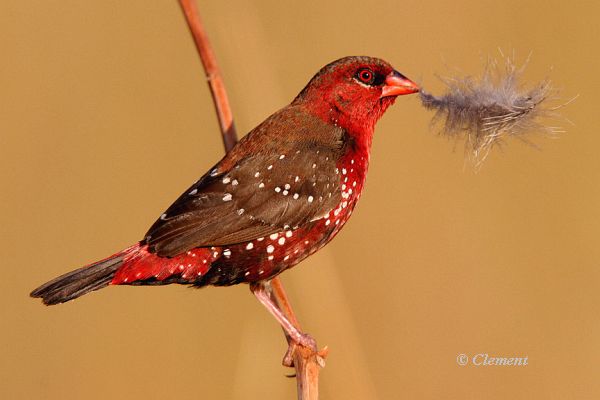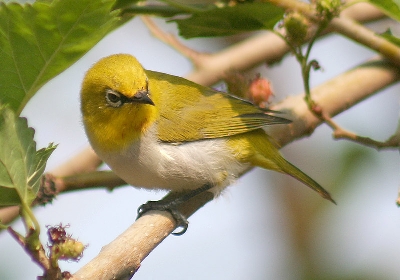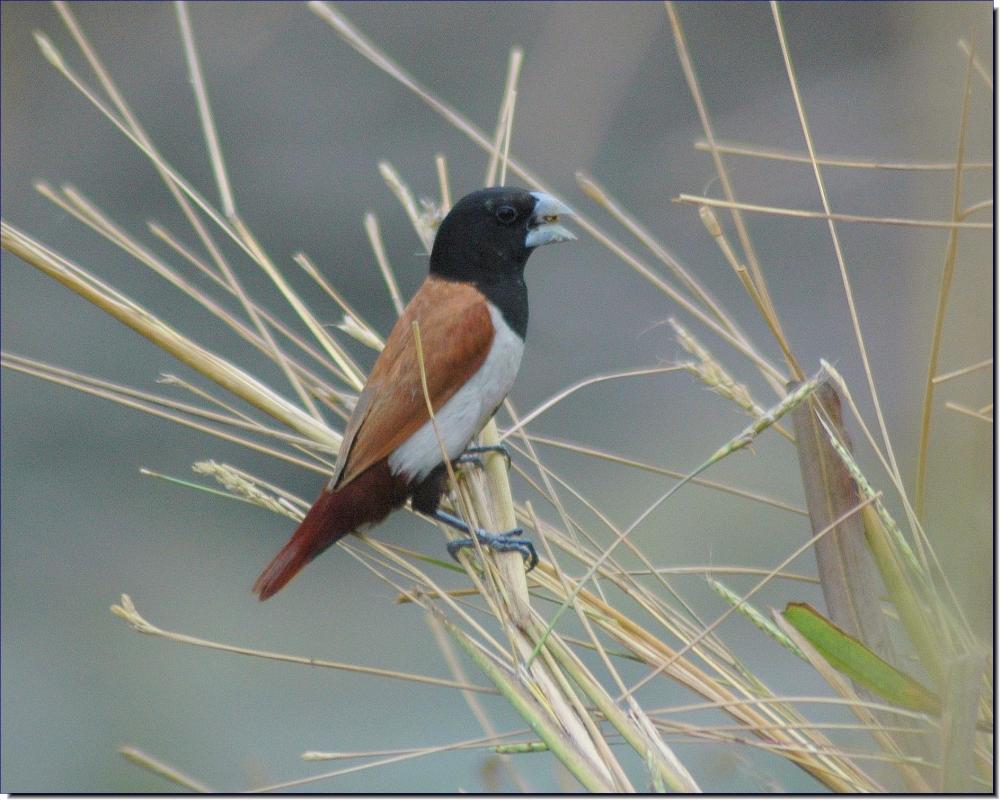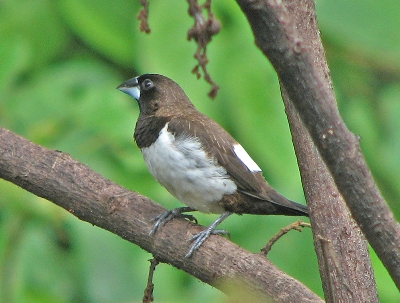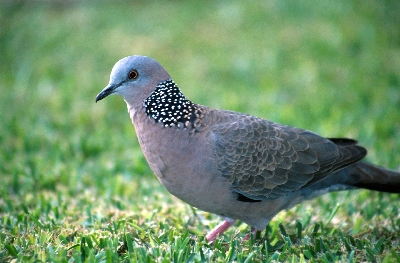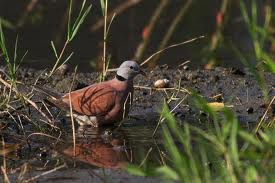Chivit, Pardal, Bico-chumbo e Otro pastro-pastro Macaísta
by Luis F. Baptista PhDClick on the SEARCH icon and enter his ID number (35568) to be taken to his personal page
"Hovering" the mouse pointer over a Portuguese or Maca�sta word will often show its English translation.
One of the most important events of my life was when during my third year in university my friend Chris Wemmer recommended that I read Nobel laureate Konrad Lorenz's popular book "King Solomon's Ring". This classic was my first window into the world of Animal Behavior and Animal Communication in particular. For the first time I learned that animals talked to each other in ways similar to humans, using gestures and ritualized sounds and touch. I also learned, to my surprise, that one could make a living studying the language of animals.
In the fall of 1967 I enrolled as a PhD student at the University of California at Berkeley, California and in the spring of 1968 began my work on song dialects of birds. It was already known that White-crowned Sparrows (Zonotrichia leucophrys), a common North American species, learned songs from adults in the population and that cultural differences arose in isolated populations giving rise to regional dialects, in the same way that regional dialects arise in human populations. For example a native of Minho sounds different from a native of Alentejo. As yet another example, a native of Macau speaking Portuguese is often readily identified because Maca�stas tend not to use the muted vowels typical of continental Portuguese.
I tape-recorded thousands of songs of White-crowned Sparrows from many regions and then analyzed these songs on a special computer which translated sounds into pictures called "sonograms". By comparing sonograms one could tell how accurately one bird imitated the sounds produced by another bird.
I thus learned that White-crowned Sparrows from different parts of the San Francisco Bay region sang with specific accents that identified the area from whence they came. I mapped out dialects in Oregon, Washington, British Columbia, and when these birds came on migration to San Francisco I could immediately tell where they came from by their accents and thus readily distinguished visitor birds from permanent residents. Birds at boundaries between two dialects were often "bilingual", i.e. they sang dialects from both neighboring populations. With experience I did not need the computerized diagrams to identify dialects, I could now hear the differences.
I went on to study dialects in songs of many species of birds in many regions of the world: boreal forests in Holland, Germany and through much of North America, the cloud forests of St. Lucia in the Caribbean, The Ecuadorian Andes, rainforests in New Guinea and Costa Rica, to name a few. When I began this work in the spring of 1968 there were perhaps less than two dozen scientists studying dialects in bird songs. Today my colleagues are legion, distributed throughout the world including the universities of Lisbon and Coimbra in Portugal.
Our work on song dialects is of interest not only to ornithologists, but also to developmental psychologists, linguists, population geneticists and cultural anthropologists, notably because of the many parallels between speech development in humans and dialect development in birds. For example both human speech and bird song are learned optimally during an early "time window" when both birds and children are young. Secondly, language acquisition in children and in birds is more efficient with living interacting teachers rather than tape-recorded sounds or videos. Language in humans and songs in birds are stored mostly in one hemisphere of the brain: and there are many other parallels. Scientists believe that by studying dialect systems in birds we may better understand language development in humans.
I am often asked when my interest in birds began. Typical of many ornithologists my love for birds began very early in childhood. Actually my first memory of an encounter with a bird was not particularly pleasant. After the fall of Hong Kong to Japan on December 25, 1941, my family and I moved to neutral Macau where we stayed until the end of the Pacific war. My brothers kept a flock of leghorn chickens to provide us with eggs. I must have been three or four years old when our leghorn rooster flew up towards me and with its leg spur drilled a hole in my left temple. I was bleeding profusely! My mother wrapped me in a blanket then carried me, running and sobbing all the way, to Dr Germano RibeiroClick on the SEARCH icon and enter his ID number (1553) to be taken to his personal page's home a few blocks away. The good doctor stemmed the flow of blood then asked us: "Quando logo comind� eu veng com� car� di galinha""When will you ask me to come and eat chicken curry". I still have that scar on my left temple, but fortunately there is no scar in my psyche and birds still fascinate me.
On my eighth Christmas in Hong Kong my brother Gaspar presented me with a pair of blue Australian parakeets (Melopsittacus undulatus). My father added a tiny red Strawberry Finch (Amandava amandava) to my growing menagerie. The song of the Strawberry Finch is a series of flute-like sounds on a descending scale, one of the most beautiful sounds in the world. Canaries soon followed and tiny finches we called Bico-chumbo which will be dealt with at greater length below. I learned to flutter my lips and blow through my teeth producing sounds similar to canary songs. To my amazement my male canary soon sang just like me.
In the book "King Solomon's Ring" mentioned earlier, Dr. Lorenz pointed out that by keeping birds one soon gets to know intimately about their habits. However, studying them in the wild enables us to learn what they really do in a natural setting and to marvel at how they adapt to their environments. Here below I summarize some of my early observations and experiences with Chinese birds in captivity and in the wild. The first purpose of this essay is to preserve for prosperity Maca�sta names for birds. Some of these names are unique to our dialect, some are names of birds familiar to early Portuguese settlers in Macau, but applied to local birds which reminded them of species familiar to them back home. Some names represent human perceptions of sounds the birds themselves made. The study of birds has enriched my life in ways that cannot be put to words. The second reason for this essay then is that in sharing these early experiences I hope to pass to you some of the joy the birds have bestowed on me.
Chivit
This diminutive 4.5 inch creature is probably the most familiar bird to Maca�sta boys. It is basically green in color, yellow beneath the throat and tail, grey breast and belly and buff sides. The dark brown eye is surrounded by white spectacles which is the origin of its Chinese name Paak ngan huen or "white-eye ring". The English name for this bird is "white-eye". There are some 150 species of White-eyes living in the Old World, but only one species in Hong Kong. White-eyes space out in pairs during the breeding season. In the fall they gather in large flocks consisting of as many as 50 or100 birds. They are very active birds, and as the flocks members move along, individuals keep in contact with each other by producing a bell-like "tzeee" call. This is a most wonderful sound, one that would cheer any person who is in a depressed mood. Single birds separated from their flock will utter a loud "CHIVIT(!)", the origin of its Maca�sta name.
Their nest is a tiny cup of fibres, sometimes lined with moss or cotton. It is thin walled but very strongly constructed. Some 3 to 4 eggs form each clutch which hatch after about 10 days of incubation.
This is probably the most popular of all birds kept by the Cantonese community. I recall that each chivit cost about 60 or 70 cents Hong Kong currency. However, the serious bird keeper would place his chivit in a cage hand-hewn during the Ching dynasty and the bird would be drinking and eating from Ching dynasty porcelain cups. Moreover, each cage may also have a small porcelain vase in which tiny flowers are placed each day. A complete set of chivit porcelain consists of four perfectly matched cups and a vase with identical design. The cage may also contain a tiny stainless steel fork protruding from an ivory or blackwood base which clips on to the cage side. This base may be carved in the shape of a crab, butterfly, or cicada, the latter the symbol of longevity. This fork is called a "Ma Tai Chaap" or water chestnut fork; and that is exactly what it is for, to hold a peeled water chestnut for the precious pet bird.
Sometimes a diminutive ivory cage hangs on the cage side in which are placed tiny baby grasshoppers. The chivit will pull one of the hapless insects through the bars as dessert. In 1990, I visited the bird market in Kowloon and found that a complete Ching dynasty chivit porcelain set fetched about $1000 Hong Kong. So precious is this bird and so valued its song that the owner often wants to give it the best, if he or she can afford it.
A baby chivit removed from its nest and hand-raised will be very tame and enjoy being "preened" by its owner, i.e. if one rubs it with its finger it closes its eyes and raises all its feathers, an expression of a state of ecstasy. chivits do this to each other in the wild, an expression of affection. A hand-raised chivit will also readily learn the song of other birds. The Cantonese enjoy placing baby chivits next to a cage containing an African Green Singing Finch (Serinus mozambicus). The chivit will learn to produce all the beautiful warbles and trills of the finch, one of the favorite songs of the Chinese community.
Humans have long been thought to be the only creatures with language traditions, i.e. their language is learned and passed down the generations. All other animals have always been thought to be creatures of instinct, e.g. pigeons or chickens hatched from eggs will as adults produce all the sounds of their species' vocabulary with no exposure to a tutor. This is not true, however, for the more "advanced" birds, those that ornithologists call songbirds or oscines. In the late eighteenth century, an Austrian scientist, the Baron von Pernau, raised European finches with tutors of other species and showed that their songs were learned. This was considered a great breakthrough in science, that songbirds, creatures lower than humans, were capable of learning sounds and language. The Chinese have probably taught chivits songs of finches for hundreds of years without giving any thought to its scientific significance. Instructed by my Chinese friends I taught chivits songs of other species as a boy; it was not until the 1960's when I was introduced to the field of ethology that I appreciated the significance of my boyhood experiences. A professor Thorpe from Cambridge University published a book in 1961 describing his experiments on how a European Chaffinch (Fringilla coelebs) learned songs during an early time window of 13 months, and that this learning gave rise to regional dialects such as I described in my introduction. With modern instruments, professor Thorpe had repeated von Pernau's experiments of the late eighteenth century: this book was considered a landmark in the field.
Pastro-tira-sorte Fortune-teller bird
This is a handsome species, a little larger than a sparrow, pearly-grey in general body colouration, with a black head, two white cheek patches, a bright red bill and a red ring around each eye. This bird was originally a native of Java and Bali, but has been advertently or inadvertently introduced to many parts of the world. It is believed that it was first introduced to China during the Ming dynasty. This is the favorite of Chinese fortune-tellers, thus the Maca�sta name tira sorte.
The fortune-teller keeps each bird in a tiny cage. A customer pays him the required fee and he then opens the cage door to let the bird out. The bird hops to a small box full of numbered sticks and pulls one out. The fortune-teller then slides open a matchbox containing unhusked rice grains. The bird takes one grain as his reward and returns to his cage where he is shut in. The fortune-teller now matches the number on the stick with a numbered card kept in a file; each card is an account of one's fortune. He now reads the "fortune" from the card to the customer.
Some fortune-tellers train the bird to go directly to a card file and pull out a fortune-card. I visited Mexico City in 1996, and as I was sitting at an outdoor cafe with my friends Admiral Manuel Rodriguez and his nephew Juan, a Mexican fortune-teller came to us with a canary which was trained to select fortunes from a card file. I asked if this custom was brought to Mexico by immigrant Chinese, and Admiral Rodriguez answered yes, through the Spanish Manila galleons that brought trade from the Orient.
Flocks of Passaro-tira-sorte are regularly seen in Hong Kong or Kowloon, notably in the Sai Kung area. They are thought to be descendants of escaped cage-birds.
Bico-chumbolead-beak
Three species of tiny 4.5 inch long birds, members of the genus Lonchura, are known collectively as Bico-chumbo in Maca�sta. This is because their bills are silver-grey, the color of lead.
The Spice Finch Lonchura punctulatawas the most common of the three, occurring in large flocks, notably in winter. Their nest consists of a large untidy ball of grass and weeds. These birds have been known to lay clutches of six to seven eggs per nest. They tend to nest in colonies and an old account that I read described two large Monkey Puzzler Trees (Araucaria araucana) in Macao in which these birds bred in great numbers.
The second species we called Bico-chumbo is known technically as Lonchura atricapilla. The British call this and related species "nuns". It has the chumbo-coloured bill attached to a black head and a brown body, thus the British name, Black-headed nun. The colours are remarkably like those of the habit of a Canossian nun, the order that taught at St. Mary's school in Kowloon. The name "nun" is thus very appropriate for this species.
This is a bird of reed-beds where they may be found in flocks of up to 60 in the fall. They are especially common in marshes at Deep Bay, Kowloon. Typical of their family, the Estrildidae, they build a ball-shaped nest of grass with a small round side entrance, placed in a low bush or clump of grass. In the 1950's I watched a pair of these Bico-chumbos pulling long stems of green grass growing on the slopes below La Salle College, Kowloon. They then flew across the street to a flame-of-the-forest tree where they had built a large oval-shaped nest some 30 feet above the ground. Breeding has been established by others only very recently at Mai Po marsh. My observation was probably the first documented breeding of this species in the colony.
The third species of Bico-chumbo, Lonchura striata, is known as the White-backed Mannikin in English. In the Metropolitan Museum of Art in New York is a beautiful silk screen on which two of these birds are depicted. They were painted by the Sung Emperor Hui-Tsung who lived between 1101 to 1125 A.D. These are remarkably accurate illustrations of this species: the emperor had somehow managed to capture with paint and brush the alertness and sprightly vitality of this tiny bird. It is difficult to imagine that this painting was completed over 800 years ago.
These are very social birds and a flock will often sit in a row touching each other's bodies. A group will roost in the same nest at night. This fondness for each other's company has earned them the American name "Society Finch". White-backed Munias were domesticated by the Chinese over 200 years ago. By "domesticated" one means that humans have selected for very tame birds that will breed freely in small cages. Like domestic pigeons or chickens they have been selected for various colors. The wild bird is mostly dark brown with very fine white streaks: domestic birds come in browns, whites, fawns, reddish fawn or spotted with white and any of the other colors. Some even have a crown of feathers, reminiscent of the tonsure on St Anthony of Lisbon.
Domestic munias will incubate and hatch eggs of other species and raise the nestlings to maturity. For this reason aviculturists have used them as "bantams" to hatch eggs of rarer finch species. Because they are so docile and so readily bred in captivity, these birds have been subjects of important work on how birds learn songs through vocal tradition. Captive bred nestlings have been shown to learn their songs directly from their father and ignore the songs of other males they can hear. Biologists call this "vertical tradition". Genes are passed to sons along with song traditions. This is in contrast to canary fledglings, that will learn songs from one or more males they can hear that are not blood-related to them. Biologists call this "oblique tradition".
Rola Dove
Three species of doves occur in Hong Kong colony. The Laceneck Dove is the most common of the three and is resident throughout the year. They form big flocks in winter but exist as pairs in the spring and summer, each pair defending a territory. They are mostly brown with a necklace of black and white feathers.
The male has a spectacular nuptial flight display to impress his lady: he flies straight up towards the sky for 100 or 200 feet, and then spreads his wings and tail, gliding down towards earth to land on a perch. I remember them being extremely common on Nathan Road, Kowloon, where they bred in the banyan trees.
The nest is very flimsy and untidy and may consist of just a few sticks, pine needles, grass stems or roots. I recall as a boy reading about a Portuguese legend which told of God teaching birds how to build their nests. While God gave these lectures, doves preferred to be elsewhere to play. When they did finally return, God's instructions were almost over so that the doves only learned part of their lessons; thus their "poorly built" nests. Two white eggs are laid and incubated by both parents. Pigeons and doves are unique among birds in that both parents feed their young on a special "pigeon milk" manufactured in their crop. This substance looks like cottage cheese, and chickens fed pigeon milk will grow faster than chickens fed on some other diet. This milk contains a special chemical, a growth factor, as yet unidentified that accelerates and enhances the growth of chicks.
Rola fogo Flame dove
This is the smallest of the three Rola species. The body coloration of the male is a bright red-brown, thus its Maca�sta name Rola fogo. The female is mostly brownish grey. This species is known only as a migrant, arriving in the colony from parts north, beginning mid-September, and leaving in the spring. Large flocks may sometimes be seen feeding on wet paddy fields along with snipe.
Rola scama Scaly dove
The brown feathers on this dove's wings are edged with buff giving it a "scaly" effect; thus its Maca�sta name Rola scama (derived from the Portuguese escama). They are seen in this region only in the fall and winter when they form flocks of 10 or 20 birds, feeding on the paddy fields. In the spring they tend to move into wooded ravines to feed on berries, and then fly northwards again.

